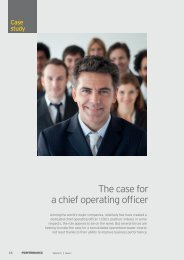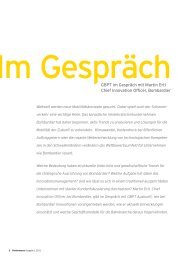PERF RMANCE 04 - The Performance Portal - Ernst & Young
PERF RMANCE 04 - The Performance Portal - Ernst & Young
PERF RMANCE 04 - The Performance Portal - Ernst & Young
You also want an ePaper? Increase the reach of your titles
YUMPU automatically turns print PDFs into web optimized ePapers that Google loves.
Boundary-spanning and helpseeking<br />
behaviors<br />
<strong>The</strong> idea of building a “connected<br />
enterprise“ seems a commonsense<br />
goal. <strong>The</strong> study of connectivity in large<br />
organizations follows a long tradition of<br />
academic and management scholarship. In<br />
his landmark 1973 article, “<strong>The</strong> strength<br />
of weak ties,” sociologist Mark Granovetter<br />
observed the extent to which bi-directional<br />
communication taking place between two<br />
colleagues is indicative of the strength of<br />
their social ties to one another. He argued<br />
that weak ties, represented by infrequent<br />
interactions among peers, had significant<br />
value for organizations as they formed a<br />
channel for the exchange of information.<br />
Granovetter linked weak ties directly to<br />
cohesion among peers and saw the analysis<br />
of social ties as a way to highlight valueproducing<br />
relations between groups.<br />
In his 1992 book Structural holes: <strong>The</strong><br />
social structure of competition, theorist<br />
Ronald S. Burt argued that two people<br />
who provide novel and non-redundant<br />
information in a social structure represent<br />
holes in the social network — and that<br />
the spanning of these structural holes<br />
provides the mechanism relating weak<br />
ties to positive outcomes. In Burt’s theory,<br />
“<strong>The</strong> value a manager adds to a firm<br />
is his or her ability to coordinate other<br />
people: identifying opportunities to add<br />
value within an organization and getting<br />
the right people together to develop the<br />
opportunities. Knowing who, when, and<br />
how to coordinate is a function of the<br />
manager's network of contacts within<br />
and beyond the firm” (1997). Thus, the<br />
value of employees within an organization<br />
largely lies in the contacts that they<br />
develop over time.<br />
<strong>The</strong>se well-functioning ties can translate<br />
into more efficient operations via improved<br />
information flows; one clear example of<br />
which can be found in “help-seeking”<br />
behaviors within the enterprise.<br />
In his 2010 book Enterprise 2.0,<br />
MIT research scientist Andrew McAfee<br />
describes an employee at a large<br />
firm, searching for someone who can<br />
do the following:<br />
“. . . keep her from reinventing the wheel,<br />
answer her pressing questions, point her<br />
to exactly the right resource, tell her about<br />
a really good vendor or consultant, let her<br />
know that they were working on a similar<br />
problem and had made some encouraging<br />
progress, or perform any of the other<br />
scores of helpful activities that flow from a<br />
well-functioning tie.” (McAfee 2010)






